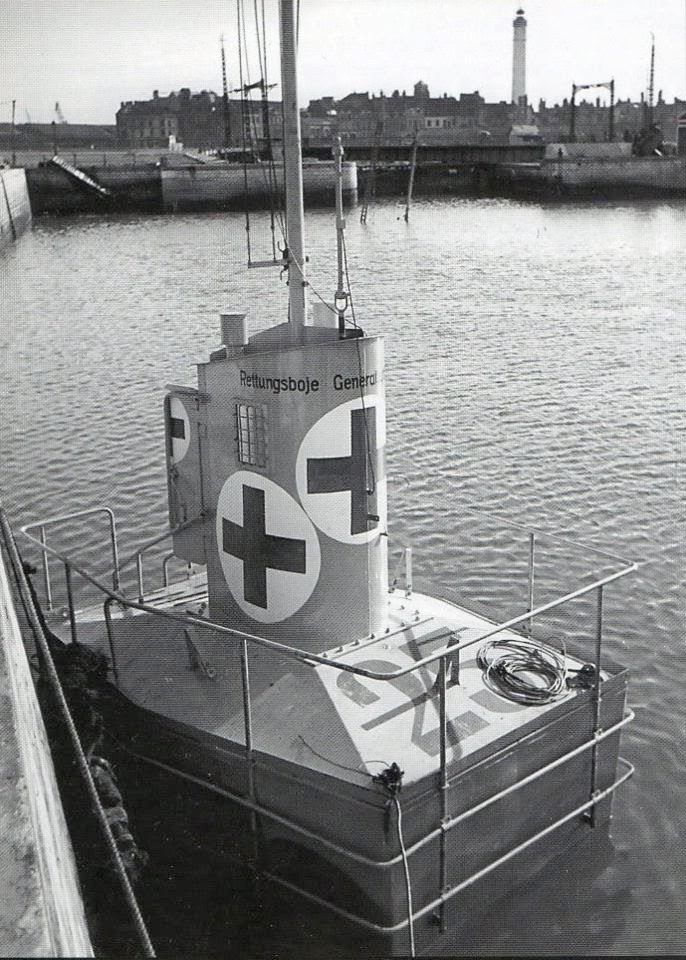Did you know?!! ... (Rettungsboje)
Thu Feb 01, 2024 4:55 pm
me neither! ...
Floating rescue buoys (German: Rettungsboje)
Pilots' lives were valuable, which is why life buoys were created.
Floating rescue buoys (German: Rettungsboje) were designed by the German Air Ministry in 1941 at the instigation of Ernest Udet. Anchored far from the shore, they saved many German pilots. Thanks to them, it was not too late to save them - after ditching the plane and swimming to them, the pilots could take shelter inside them from the water and cold.
During World War II, the Luftwaffe built and anchored rescue buoys in the waters of the English Channel in which pilots of downed German planes could survive.
Inside the buoy there were comfortable rooms for 4 people. Thanks to the supplies, they were able to stay in the buoy for several days. In an emergency, even the crews of several planes could fit inside.
The crew had two bunk beds, a cabinet with first aid equipment, dry clothes and shoes, food rations and drinking water at their disposal.
The buoys had electric lighting. Power was taken from batteries, and in the event of their discharge or failure, kerosene lamps were available.
On the upper deck of the buoy there was a tower with a radio transmitter mast. You could enter through them. There was a ladder on the waterline leading into the tower, at the top of the balustrade.
Hot meals could be prepared on an alcohol stove. There was even cognac to relieve the cold and cigarettes to calm the nerves. The set also included games, stationery, and playing cards to provide entertainment until the rescue services arrived. Once the rescue ship arrived, depleted supplies were immediately replenished.
A 100 m rope was attached to the buoy and held on floats in visible colors (alternating yellow and red). Before the forced ditching, the line arrangement in the water showed the pilots the current sea current. It also allowed access to the buoy when the sinking plane was drifting. There was a rescue ball on a 10-meter rope already on the buoy, which could be thrown to colleagues if necessary.
The fact that there were survivors on the buoy deck was signaled by hoisting a flag with yellow and red stripes. Red and white locator lights were lit at night.




And: The last of the German rescue buoys that floated in the North Sea in World War II
https://www.outono.net/elentir/2024/01/ ... ld-war-ii/
Floating rescue buoys (German: Rettungsboje)
Pilots' lives were valuable, which is why life buoys were created.
Floating rescue buoys (German: Rettungsboje) were designed by the German Air Ministry in 1941 at the instigation of Ernest Udet. Anchored far from the shore, they saved many German pilots. Thanks to them, it was not too late to save them - after ditching the plane and swimming to them, the pilots could take shelter inside them from the water and cold.
During World War II, the Luftwaffe built and anchored rescue buoys in the waters of the English Channel in which pilots of downed German planes could survive.
Inside the buoy there were comfortable rooms for 4 people. Thanks to the supplies, they were able to stay in the buoy for several days. In an emergency, even the crews of several planes could fit inside.
The crew had two bunk beds, a cabinet with first aid equipment, dry clothes and shoes, food rations and drinking water at their disposal.
The buoys had electric lighting. Power was taken from batteries, and in the event of their discharge or failure, kerosene lamps were available.
On the upper deck of the buoy there was a tower with a radio transmitter mast. You could enter through them. There was a ladder on the waterline leading into the tower, at the top of the balustrade.
Hot meals could be prepared on an alcohol stove. There was even cognac to relieve the cold and cigarettes to calm the nerves. The set also included games, stationery, and playing cards to provide entertainment until the rescue services arrived. Once the rescue ship arrived, depleted supplies were immediately replenished.
A 100 m rope was attached to the buoy and held on floats in visible colors (alternating yellow and red). Before the forced ditching, the line arrangement in the water showed the pilots the current sea current. It also allowed access to the buoy when the sinking plane was drifting. There was a rescue ball on a 10-meter rope already on the buoy, which could be thrown to colleagues if necessary.
The fact that there were survivors on the buoy deck was signaled by hoisting a flag with yellow and red stripes. Red and white locator lights were lit at night.




And: The last of the German rescue buoys that floated in the North Sea in World War II
https://www.outono.net/elentir/2024/01/ ... ld-war-ii/
Re: Did you know?!! ... (Rettungsboje)
Thu Feb 01, 2024 5:28 pm
There's a period war movie that features one of these (One of Our Aircraft is Missing?).
Re: Did you know?!! ... (Rettungsboje)
Thu Feb 01, 2024 8:32 pm
I believe the English had something comparable....I recall seeing these in old book about the Battle of Britain.
For crews it was a waiting game to see who reached them first.
For crews it was a waiting game to see who reached them first.
Re: Did you know?!! ... (Rettungsboje)
Fri Feb 02, 2024 4:47 am
Re: Did you know?!! ... (Rettungsboje)
Fri Feb 02, 2024 7:48 am
Here is a good video on the one Archer photographed.
Restoration efforts are well underway.
https://www.youtube.com/watch?v=a90_QdrKo1Q
Restoration efforts are well underway.
https://www.youtube.com/watch?v=a90_QdrKo1Q
Re: Did you know?!! ... (Rettungsboje)
Fri Feb 02, 2024 10:33 am
Looks like I need to revisit... they've put a lot of work into that thing since I was there!
Re: Did you know?!! ... (Rettungsboje)
Fri Feb 02, 2024 12:07 pm
That is fascinating! I wonder if any engineering drawings remain?